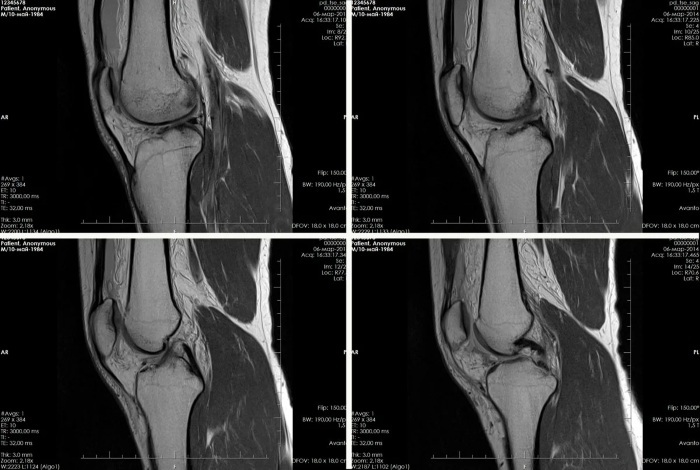Patellar chondromalacia is a serious condition that causes wear and tear of the cartilage. Its smooth surface softens and the friction of the bones becomes painful.
Concomitant symptoms appear, indicating a certain degree of the disease, with which it is important to consult a traumatologist or orthopedist in a timely manner. Correctly selected therapy after comprehensive diagnostics will prevent complications.
Record content:
- 1 What is patellar chondromalacia?
- 2 Reasons for development
- 3 Risk group
- 4 Classification of pathology
- 5 Symptoms
- 6 Diagnostic methods
-
7 Treatment for chondromalacia of the patella
- 7.1 Drug therapy
- 7.2 Surgery
- 7.3 Other methods
- 8 Rehabilitation process
- 9 Dispensary observation
- 10 Folk remedies
- 11 Forecast
- 12 Video about patella chondromalacia
What is patellar chondromalacia?
Chondromalacia is a pathological process that negatively affects cartilage tissue, contributing to its destruction. The protective functions are lost. Friction of the patella and femur causes severe pain. A common disease of the musculoskeletal system, which is diagnosed in 10-19% of cases. Young people are more likely to face pathology.
Reasons for development
Chondromalacia of the patella of 1-4 degrees is provoked by the following reasons:
| Name | Description |
| Increased stress on the knee joint | Intensive sports training, strength exercises negatively affect the cartilage tissue and provoke the development of pathological processes. |
| Deformity of the lower limbs | A pathological condition in which the angle between the femur and tibia changes. Varus or hallux valgus also leads to the development of the disease. There are changes in the structure of the knee joint. The cartilage tissue becomes thinner. |
| Incorrect workouts | This is more true for newcomers to sports who do sports exercises incorrectly. When starting a workout, it is recommended to use the services of a qualified trainer. |
| Congenital anomalies | The patella does not develop properly from birth. |
| Overweight | The increased body weight puts more stress on the knee joint. |
| Knee injury | This is more about minor injuries, but often repetitive. Sports or physical injuries affect the patellar ligaments. |
| Elderly age | In an aging body, cartilage wear out faster. |
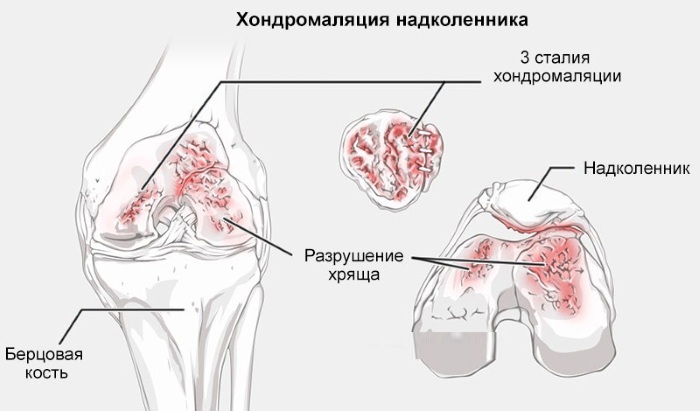
There are also numerous provoking factors against which the elasticity of the cartilaginous tissue decreases and chondromalacia of the patella develops:
- flat feet, clubfoot (incorrect positioning of the foot leads to a violation of the location of the patella);
- deforming osteoarthritis;

- gout;
- deposition of large amounts of salts;
- the formation of osteophytes.
Fractures and cracks in the bones also provoke the development of patellar chondromalacia. The same applies to systemic diseases of cartilage and connective tissue, rheumatism, and posture disorders.
Risk group
Chondromalacia is the result of friction between the bones and the patella in the knee area.
The following people may face the disease:
- Teens or young people who are as active as possible.
- Elderly people in whom chondromalacia is the result of arthritis.
- Due to the structure of the pelvic bones, women are more likely to encounter pathological processes in comparison with representatives of the strong half of humanity.
- During running and jumping, the load on the knee increases. The same goes for intense training.
Grade 1-2 chondromalacia of the patella also occurs in people who do not properly distribute weights during sports activities. This category includes women running.
Classification of pathology
Pathological processes develop in stages.
At each stage, certain degenerative changes occur and characteristic clinical symptoms occur:
| Name | Description |
| First degree | The cartilage tissue thickens, softens and swells. The patient is worried about discomfort in the knee joint.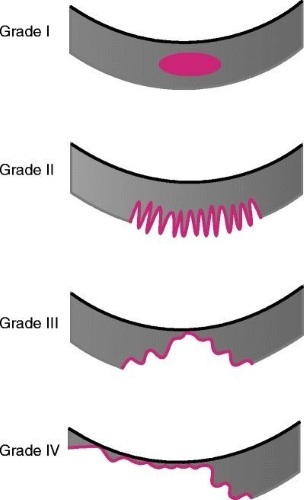
|
| Second degree | Degenerative processes provoke the appearance of grooves and cracks in the joint, as a result of which a severe pain syndrome occurs after even a slight physical exertion. |
| Third degree | Depressions and cracks enlarge, significant deformation opens the bone. Degenerative processes affect connective tissue. |
| Fourth degree | The most severe degree of patellar chondromalacia. At this stage, the subchondral bone is exposed. |
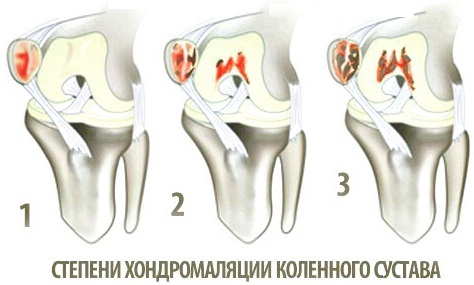
In the last stages of the development of degenerative processes, strong painful sensations disturb a person even at rest, when they touch the knee, they intensify. Mobility is limited, a person is forced to use special means for movement (crutches, cane).
Symptoms
The clinical picture of the disease will allow the traumatologist to establish a preliminary diagnosis and prescribe the most informative examination.
Pathological processes, given the degree of patellar chondromalacia, are accompanied by the following symptoms:
| Name | Symptoms |
| I degree |
|
| II degree |
|
| III degree |
|
| IV degree |
|
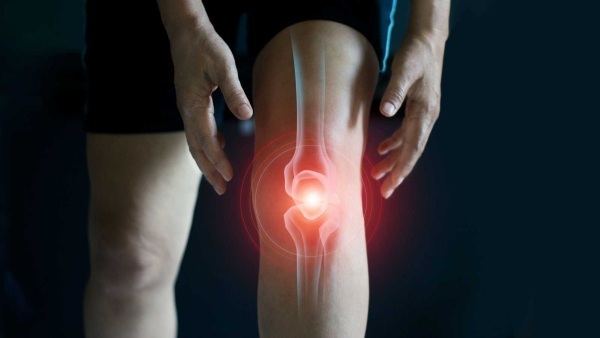
It is important to establish a diagnosis at an early stage of the disease in order to timely start treatment and prevent possible complications.
Diagnostic methods
A comprehensive examination by a traumatologist is necessary for an accurate diagnosis. The specialist will conduct an examination, refer you for diagnosis and, taking into account the results obtained, select a treatment regimen.
Chondromalacia of the patella 1-4 degrees help to identify the following examination methods:
| Name | Description |
| X-ray | Diagnostics allows you to view the knee joint, identify its deviation and changes in anatomical structures. |
| Magnetic resonance imaging (MRI) | A diagnostic method by which the doctor examines in detail the structures of the knee joint together with the patellar cartilage. |
| Blood analysis | The results will help confirm or deny the development of autoimmune diseases. |
| Arthroscopy | Diagnostic method performed under general anesthesia. The doctor inserts instruments and a camera through the holes made to visually view the knee joint and identify degenerative processes. |
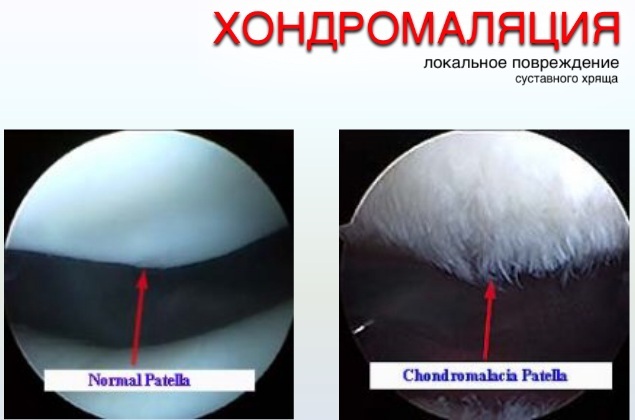
It is necessary to differentiate the disease, since many pathologies are accompanied by similar clinical symptoms (rheumatoid, psoriatic arthritis).
Treatment for chondromalacia of the patella
Therapy for chondromalacia of the patella is selected by a traumatologist or orthopedist after a complete examination. Patients are prescribed medications, surgical intervention is indicated in emergency or difficult situations. The use of traditional medicine is allowed, if there are no serious contraindications.
Drug therapy
Medicines are selected by the doctor, taking into account the degree of development of pathological processes and the individual characteristics of the human body. Many drugs provoke side effects, so it is important to strictly adhere to all the prescriptions of a specialist.
The following medications are used to treat patellar chondromalacia:
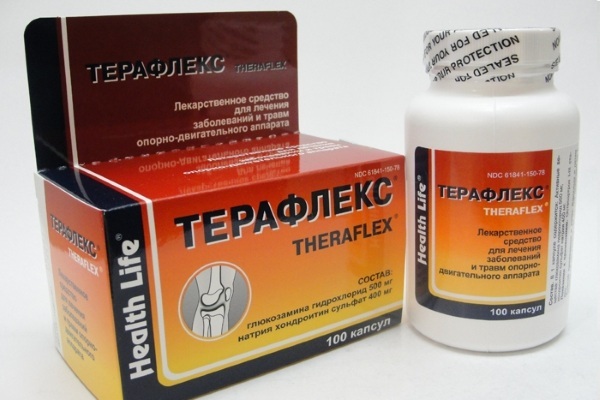
| Drug group | Name | Application |
| Non-steroidal anti-inflammatory drugs | Meloxicam, Indomethacin | Medicines reduce pain and have anti-inflammatory effects. The tablets must be taken orally with meals with plenty of water. The daily dosage for adults depends on the patient's condition and is 7.5-15 mg. |
| Chondroprotectors | Structum, Teraflex | The drugs stimulate the regeneration of damaged cartilage. The medicine is taken orally, washed down with water, without chewing. The adult dosage is 1-2 capsules 2 times a day. The course of therapy lasts 6 months. |
| Hyaluronic acid preparations | Fermatron, Synokrom | Medicines are needed to restore the composition and structure of the synovial fluid. The injections are given by qualified medical personnel. The injection is carried out directly into the cavity of the affected knee joint. Adults are prescribed 1-3 injections, depending on the severity of the disease. The course of therapy lasts 1-3 weeks. |
| Means for improving microcirculation | Lioton, Heparin Ointment | Medicines improve the rheological properties of blood, restore blood circulation and vascular structure in the affected area of the knee joint. The gel is applied to the affected area of the knee 1-3 times a day, rubbing in with light massage movements. A strip of 3-10 cm is enough. |
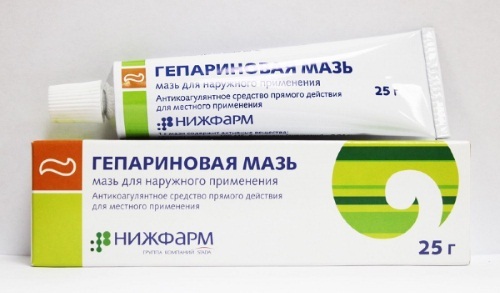
Drug therapy can stop degenerative processes and prevent them from spreading to other joints in the body. During treatment, the patient is advised to wear a special bandage that fixes the bandage.
Surgery
Grade 4 chondromalacia of the patella requires surgery when pathological processes cause severe and unbearable pain. The main goal of surgical treatment is to stabilize the patella in a physiologically correct position.
Surgical intervention is carried out by the following methods:
| Name | Description |
| Arthroscopy | During the operation, the surgeon removes the affected parts of the cartilage and flushes the cavity of the knee joint. If necessary, the specialist mobilizes the outer edge of the patella to restore knee mobility and functionality. |
| Myofasciotomy and arthrolysis | The surgeon opens the joint cavity to remove fibrous adhesions. If necessary, it cuts part of the muscles and tendons that interfere with the physiological movement of the patella. |
| Corrective osteotomy | During surgery, the doctor removes some of the femur and tibia in order to restore the mobility of the knee joint. |
| Partial arthroplasty | Surgical treatment involves replacing part of the destroyed knee joint with an artificial element. |
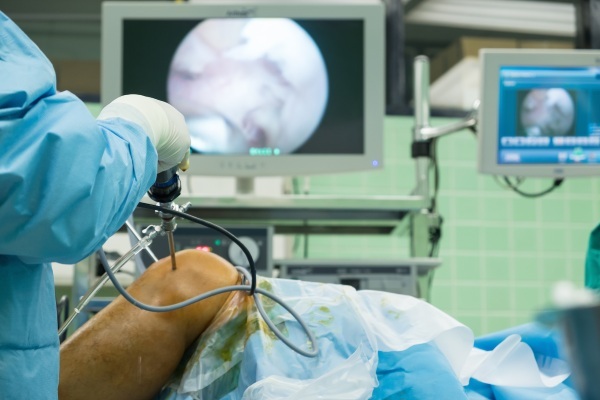
After the surgical treatment, the patient will have a long-term rehabilitation, which will help restore the functions and mobility of the knee joint. Patients are advised to strictly follow all doctor's prescriptions.
Other methods
In the complex therapy of patellar chondromalacia, physiotherapeutic procedures are used. The treatment helps to strengthen the muscles of the lower limb, restore strength and mobility.
| Name | Description |
| Ozokerite applications | The treatment has a positive effect on blood flow and muscles in the affected area. The pain syndrome decreases, the regeneration process improves, and damaged tissues are restored faster. |
| Medicinal electrophoresis | A painless procedure, during which the medicine goes directly to the inflammatory focus. The general well-being of the patient improves, painful sensations and inflammation decrease. |
| Laser therapy | The treatment helps to eliminate muscle spasm, to activate blood circulation. Eliminate also the inflammatory process and enhance regeneration at the cellular level. |
| Shockwave therapy | Already after the first procedure, the pain syndrome decreases, blood circulation is restored and metabolic processes in the affected tissues are activated. Due to improved microcirculation, damaged cartilage tissue, joint fluid, ligaments and muscles of the knee receive more nutrients. |
After reducing the exacerbation of the disease, when the edema subsides, it is recommended to perform physiotherapy exercises. Exercise helps develop the muscles and mobility of the affected leg.
The set of exercises is selected by a physiotherapist:
- Bend your healthy leg at the knee and place your feet on the floor. The diseased limb must be raised slowly at an angle of 45 degrees. The exercise is recommended to be performed 10-20 times with breaks of 30 seconds.
- Lie on a healthy side of the body. Bend the legs and abduct the thigh with the sore limb up. The exercise should be performed 20 times, then take a break for 30 seconds and repeat 2 more times.
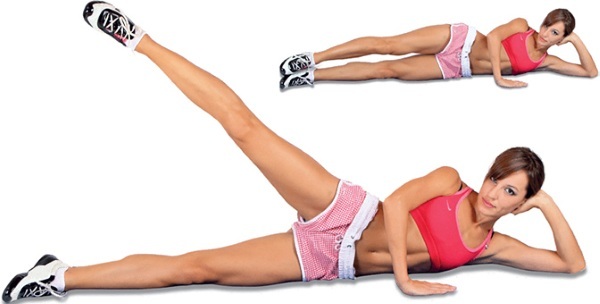
- Stand against the wall, feet shoulder-width apart. Perform slow squats against the wall. Hold for 30-60 seconds and return to starting position.
It is important to do the exercises slowly, gradually increasing the load. If there are severe painful sensations or discomfort, it is necessary to stop classes and consult an orthopedic surgeon for advice.
Rehabilitation process
The recovery period depends on the degree of development of patellar chondromalacia. In the early stages, if the patient goes to the hospital in a timely manner, 3 weeks is enough. If surgical treatment was performed, the person will need 1.5 months to recover.
During the rehabilitation period, it is useful for patients to swim, exercise on an exercise bike. Do not forget about remedial gymnastics and strictly adhere to all the recommendations of an orthopedic doctor in order to prevent a recurrence of the disease.
Dispensary observation
After the treatment, patients are advised to remember about the prevention of chondromalacia in order to prevent a recurrence of the disease. Dispensary observation of patients is shown after 2 months. An orthopedist or traumatologist conducts an examination, prescribes an X-ray. After 6 months, the patient needs to undergo a follow-up examination (magnetic resonance imaging).
Folk remedies
Chondromalacia of the patella of 1-2 degrees allows the use in a complex of recipes of healers and healers. It is not recommended to carry out therapy on your own, since serious consequences can be provoked. There is a high likelihood of an allergic reaction or individual sensitivity.
Effective folk remedies for patellar chondromalacia: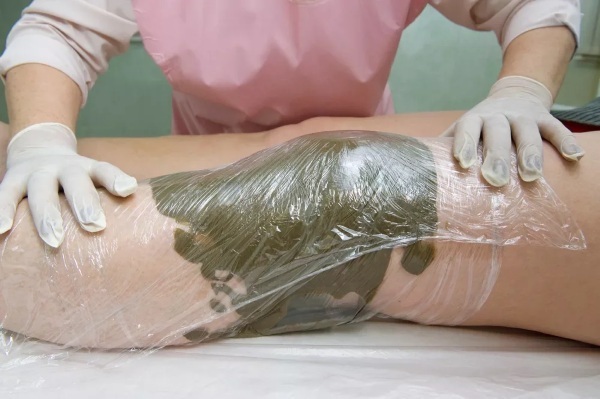
| Name | Recipe | Application |
| Grinding solution | Mix 100 ml of turpentine and rubbing alcohol (70%). Add 100 g of olive oil and 2 g of camphor. Mix all components well. | The finished rub should be applied to the affected area of the knee when severe painful sensations appear. |
| Healing compress | Mix medical bile, iodine, glycerin and ammonia in equal proportions. Mix all ingredients well until smooth. Add a small amount of honey and leave to thicken. | The finished mass should be applied once a day to the sore knee. The compress is left for a day. The medicine reduces painful sensations and signs of the inflammatory process. |
| Birch buds | Pour 1 tsp. birch buds with boiling water (1 tbsp.). Put the resulting mass on a small fire and heat for another 30 minutes. Cool, strain and store the finished medicine in a cool place. | With chondromalacia of the patella, patients are advised to take 100 ml of tincture 3 times a day. |
| Dandelion medicinal | Pour dry grass (1-2 tablespoons) with hot water (200 ml) and put on medium heat, heat for 15 minutes. Cool, strain and take the medicine inside. | The finished product is recommended to be consumed cold, 1 tbsp. 3 times a day. |
| Bean broth | Chop dried pods (20 pcs.) And cover with hot water (1 l). Put the resulting mixture over medium heat and cook for 40 minutes, not allowing the water to boil. Strain the finished broth well and cool to room temperature. | The medicine is recommended to be consumed in 0.5 tbsp. 4 times a day. |
Compresses with Dimexide help reduce inflammation and pain in the knee area during patellar chondromalacia. Lotions are made once a day for 2-3 weeks. For diseases of the knee joint, patients are also advised to drink a decoction of dried black currant leaves instead of tea.
Forecast
The prognosis is positive in most cases. It is possible to restore cartilaginous tissue and eliminate pathological processes with the help of traditional drug treatment. Complications of the patient await if he untimely went to the hospital or did not adhere to all the doctor's recommendations during therapy.
Chondromalacia of the patella is not a dangerous disease if diagnosed and treated in a timely manner. It is important to identify the pathology in the early stages of development in order to avoid negative consequences. Progressive changes of 3-4 degrees in the cartilaginous tissue will lead to serious complications, when it will be impossible to do without surgery.
Video about patella chondromalacia
Knee chondromalacia - causes and treatment:


